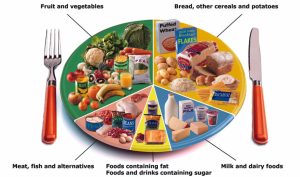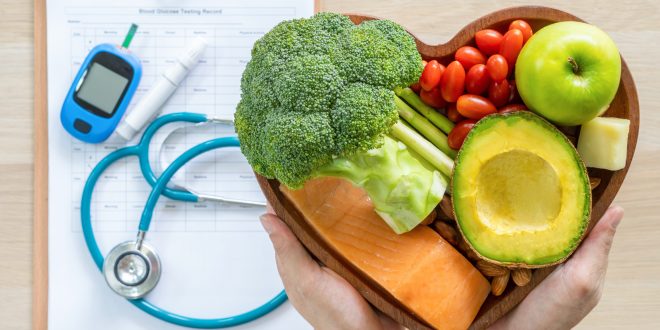A healthy diet is essential for managing diabetes. Essential components of a diabetes-friendly meal plan can help control blood sugar levels and enhance overall health and well-being. Understanding the fundamental aspects of a healthy, diabetes-friendly diet plan is essential for people with diabetes. This article focuses on the crucial elements of a well-balanced, long-lasting diet plan to manage diabetes.
Understanding Diabetes and Its Dietary Implications
What is Diabetes?
Diabetes is a chronic condition characterized by a high blood glucose level. It happens when the body doesn’t produce suitable insulin (Type 1 diabetes) or becomes intolerant to insulin (Type 2 diabetes). Gestational diabetes is a condition that occurs during pregnancy and usually occurs after childbirth, but it can increase the chance of becoming Type 2 diabetes later on in life.
Importance of Diet in Diabetes Management
Diet plays a vital part in tackling diabetes. The right amount of nutrients can help maintain blood sugar levels, control weight, and decrease the risk of complications associated with diabetes, such as heart disease or neuropathy. Essential components of a diabetic-friendly diet plan focuses on limiting carbohydrate intake, consuming foods rich in nutrients, and ensuring a balanced diet.

Core Components of a Diabetes-Friendly Meal Plan
Carbohydrate Management
Understanding Carbohydrates
Carbohydrates exert the most significant effect on glucose levels in the body. They are in food items such as rice, bread, pasta, fruits, vegetables, and dairy products. Controlling the intake of carbohydrates is crucial to maintain your blood sugar.
Glycemic Index and Glycemic Load
The Glycemic Index (GI) measures how quickly a carbohydrate-containing food raises blood sugar levels. Foods with a significantly lower GI are absorbed less quickly, increasing blood sugar. Glycemic Load (GL) examines the GI and the quantity of carbohydrates present in a particular portion of food to accurately assess the effect it has on blood sugar.
Low GI foods : Include non-starchy vegetables, whole grains, legumes, and some fruits, such as apples and berries.
High GI foods : White bread, sweet snacks, along with refined and energy-rich cereals.
Balanced Macronutrients
Proteins
Proteins are necessary to develop, repair, and maintain the body’s tissues. They also have a minimal effect on the blood sugar level and benefit the satiation process.
Sources of Protein : Lean meats, eggs, fish, poultry tofu, legumes, seeds, and nuts.
Fats
Fats are essential to maintain overall health, as they provide energy and promote the growth of cells. But the kind of fat that you consume is important.
Healthy Fats : Incorporate polyunsaturated, monounsaturated, and unsaturated fats found in avocados, nuts, olive oil, seeds, and even fatty fish such as salmon.
Unhealthy Fats : Trans fats and saturated fats should be included in processed food items such as fried or fried foods and certain meats.
Fiber-Rich Foods
Fiber is excellent for digestion and health. It also helps to slow the digestion of sugars and prevents sudden spikes in blood sugar levels. It also helps with the management of weight and satiety.
Sources of Fiber: Whole grains, legumes, fruits, vegetables, seeds and nuts.
Portion Control
Controlling portion size is crucial to managing calories and preventing excessive eating, which can cause excess weight or blood sugar rises. Using portion guides, measuring cups, and being aware of portions can help ensure that you are eating the right portions.
Regular Meal Timing
Regularly scheduled meals help keep blood sugar levels stable throughout the entire day. Inconsistent eating habits can result in fluctuation in blood sugar.
Hydration
A healthy diet is crucial for general well-being and can help manage blood sugar. It is highly recommended that you consume herbal teas, drink water, and avoid sugary drinks.
Monitoring and Adjusting
A regular check of blood sugar levels allows you to evaluate the effectiveness of a food plan. Modifications can be made based on these results, the level of physical activity, and individual reactions to different food items.
Building a Diabetes-Friendly Meal Plan
Breakfast
A nutritious breakfast sets the mood for the rest of the day. It provides vital nutrition and energy. It should have a balanced mix of proteins, carbohydrates, and fats.
- Whole Grain Oatmeal with Chia seeds in a tablespoon garnished with berries and a spoonful of Greek yogurt.
- Scrambled Eggs with whole grain toast and spinach.
Lunch
Lunch should consist of high-fiber carbohydrates, lean proteins, and healthy fats that maintain energy levels through the afternoon.
- With mixed salad greens, cherry tomatoes, chickpeas, cucumbers, and an aioli-lime dressing.
- With whole grain tortilla, avocado, lettuce, and carrot sticks.
Dinner
The meal is supposed to remain balanced and not heavy. It should include protein, vegetables, and moderate quantities of carbohydrates.
- With an accompanying side of sweet potatoes and steamed broccoli.
- Mix veggies and serve over brown rice.
Snacks
Healthy foods can help prevent overeating during meals and help control blood sugar levels.
-
- With almond butter.
- With some nuts.
- With Hummus

Special Considerations
Individual Preferences and Cultural Foods
The incorporation of individual preferences and cultural food items into a diabetes-friendly eating plan will boost adherence and satisfaction. It’s crucial to adapt traditional recipes to make them healthier, for example, using whole grains rather than refined grains or baking instead of cooking.
Dietary Restrictions and Allergies
For those with diet restrictions or allergies, such as lactose or gluten intolerance, other foods with similar ingredients that provide identical nutrients must be considered.
Weight Management
For those looking to shed weight, a deficit in calories achieved through portion control and more physical activity is crucial. A balanced diet program can help you lose weight and regulate your blood sugar level.
Exercise and Physical Activity
Exercise can affect blood sugar levels and insulin sensitivities. Therefore, it is important to plan meals in conjunction with exercise routines to avoid hypoglycemia and ensure proper nutrition.
Tips for Successful Meal Planning
Plan Ahead
Preparing meals and snacks ahead will help you keep the same food items in your pantry and ensure the right foods are provided. It also helps with grocery shopping and lessens the temptation to consume unhealthy food items.
Keep a Food Diary
Recording what you consume and drink may add insight into how various food items affect blood sugar levels. This can help identify patterns and areas for improvement.
Consult a Dietitian
A registered dietitian is a great way to favor personal advice and support to ensure that your diet program is appropriate to your needs and goals for managing diabetes.
Be Flexible
Life can be unpredictable, so it’s crucial to be flexible in your eating schedule. Making healthy choices and adjusting to changes in your lifestyle can help you keep control of your diet.
Stay Educated
Becoming up-to-date on the subject of diabetes and nutrition can help you make healthier diet choices. Researching reliable sources, attending workshops, or joining support group groups could offer additional useful information and provide motivation.
Conclusion
Making a diabetic-friendly menu is about understanding the effect of various food items on blood sugar, balancing macronutrients and fiber-rich foods, and controlling portion size. Regularly monitoring and adjusting in the context of your personal preferences and the foods you eat and planning for the future is vital to achieving success. If you adhere to these essential elements, people who have diabetes can achieve greater control of blood sugar, increase their overall health, and enjoy diversions and eating habits.
FAQs
What is a healthy, diabetes-friendly meal program?
A diabetic-friendly diet plan is a diet guide designed to benefit people with diabetes and control their blood sugar levels. It focuses on healthy diet, portion control and regular meal times and includes foods that can maintain blood sugar levels and improve overall well-being.
Why is managing carbohydrates essential for a diet that is diabetic-friendly?
Carbohydrates are the primary source of effect on the blood sugar level. Monitoring the intake of carbohydrates can reduce blood sugar spikes and ensure that glucose levels remain stable. This involves monitoring the kinds and quantities of carbs consumed.
What are low-glycemic index (GI) food items, and what are the reasons why they are suggested?
Foods with low GI levels are digested and absorbed slowly, leading to an increase in blood sugar. They are suggested for managing diabetes because they help maintain glucose levels. Some examples include whole grains and legumes, as well as non-starchy vegetables and certain fruits such as apples and berries.
How do I keep macronutrients in check when I eat?
The balance of macronutrients is achieved by including the proper proportions of protein, carbohydrates, and fats in every meal. A balanced diet could contain lean protein (like tofu or chicken) and healthy fats (like avocados or olive oils) as well as complex carbohydrates (like sweet potatoes or quinoa).
What are the excellent sources of healthy fats to include in the diabetic-friendly menu strategy?
Healthy fats are monounsaturated and polyunsaturated, and they are found in avocados, seeds, nuts, olive oil, and fatty fish such as salmon. These fats are beneficial to the heart and keep you fuller longer.
 aim specialty health Discover Expert Insights, Empower Your Wellness With Aim Specialty Health Blogs.
aim specialty health Discover Expert Insights, Empower Your Wellness With Aim Specialty Health Blogs.




